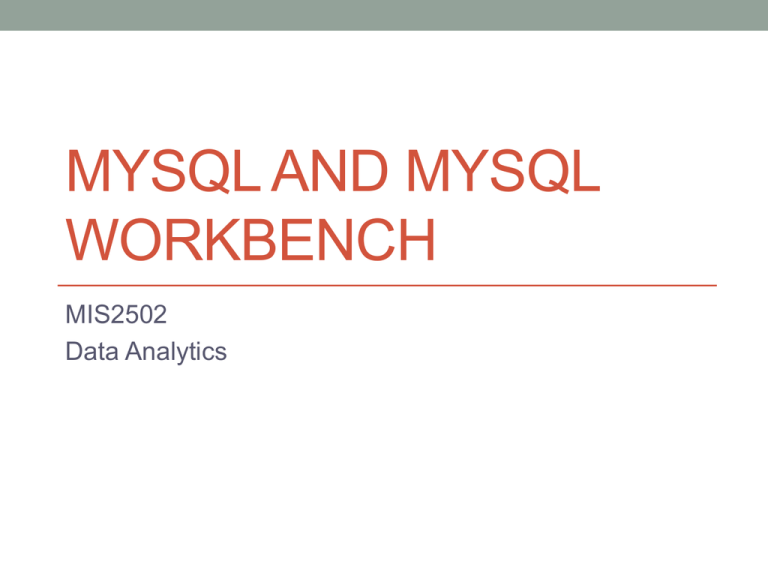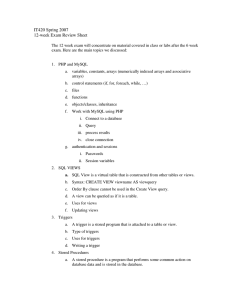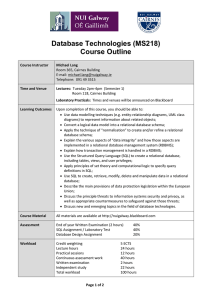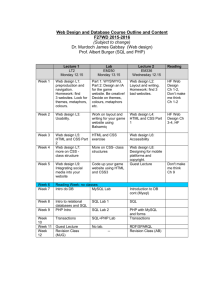MYSQL AND MYSQL WORKBENCH MIS2502 Data Analytics
advertisement

MYSQL AND MYSQL WORKBENCH MIS2502 Data Analytics MySQL • MySQL is a database management system (DBMS) • Implemented as a server What is a server? • Software specifically built to provide services to other applications Examples • • • • File server Print server Web server Database server MySQL Database Example: The web server • The web server “serves” web pages to the web browser • The web browser allows the user to interact with the server • The web browser is the “client” Request http://fox.temple.edu Response a web page Web server Interacting with MySQL • The client can either be a business application or a utility • We’re going to use the MySQL Workbench utility Request SQL query Response Query results (data) MySQL Database MySQL Workbench • Enables the user to interact directly with the database • Create and make changes to tables • Extract information from tables • Provide help creating SQL statements • Create ERDs • We’ll use SQL workbench to • Create and execute SQL commands • View query results • But we won’t use it for modeling • We want to do some things ourselves! Limits of MySQL Workbench • It isn’t meant for business users • For that, we’d construct an application Why would you do things this way, instead of allowing direct database interaction? Placing an order at Amazon • You don’t interact with Amazon’s database directly • You do it through Amazon.com Registering for a course • You don’t interact with Temple’s database directly • You do it through Owlnet Connecting to a MySQL server • This is the opening screen • You double click on a connection to connect to a server • You’ll have access to your schemas on that server We’ll give you instructions explaining how to set up your connection to the class server, based on your username and password. The MySQL Workbench interface SQL Query panel Overview tabsheet (the database schemas) How many tables are in this schema? Composing a SQL statement • Let’s just type this into the query panel Don’t worry about the syntax itself yet. We’ll get to that soon… • Notice how the words SELECT and FROM are highlighted in green. • Those are the keywords (part of the SQL language) • The black indicates it isn’t part of SQL • So they are part of the database itself, like schemas, tables, and fields To execute the query Click on the lightening bolt icon or select “Execute Current Statement” from the Query menu …and you’ll wind up with this result These are the results of the query, displayed in table form Another example • This query • gives us this The orange highlighting indicates this is a string literal, or a set of letters a numbers. In other words, what’s between the quotes isn’t a SQL command OR an element in the database The editor will catch mistakes • This is a query with no answer because “LastNam” isn’t a field in the table • Instead of query results, we now get this indicating the source of the error If the syntax is wrong… • We’ve spelled “FROM” wrong FRM isn’t green because it is not recognized as a SQL keyword! • And now we get this error • MySQL Workbench can’t tell quite what’s wrong, but it knows it isn’t a correctly formatted SQL command • It thinks “m0orderdb” is the source of the problem, but really it’s a misspelled keyword Automatically generated SQL • MySQL Workbench can generate the more complex queries for you Right-click on the customer table… …and you’ll see an editable table that you can work with. Example: Adding a row • Now we’ll add another row to the table, just like we’re filling in a spreadsheet Click on the “Apply changes to data” icon (the green check mark) The generated SQL statement • This is the SQL statement that will add the row to the database • You can make changes to the SQL, or just click “Apply” • That will send the SQL statement to the MySQL database server for processing Adding a table • In the Overview tab, choose the schema • Then double-click “Add Table” in the Overview tab • Give it a name, and then click the Columns tab • Enter column names and datatypes We’ll learn what the datatypes mean a little later… And the result is this… We’ll learn the syntax for all of these statements. But every query can be entered directly through the query panel. You’ll need to know how to create the SQL yourself, even if you use MySQL Workbench for help. It will also generate statements for • Deleting a row from the table (SQL DELETE) • Right-click on the left side of the row and select “Delete Row(s)” • Changing a row in a table (SQL UPDATE) • Delete an entire table (SQL DROP) • Right-click on the table in the Overview tab and select “Drop Table…” The bottom line • SQL Workbench makes it easy to interact with a MySQL database • It can help you compose queries through highlighting, syntax checking, and the automated query functions • In reality, a database administrator would use a combination of automated query generation and manual entry • The more complex the query, the more has to be entered manually





